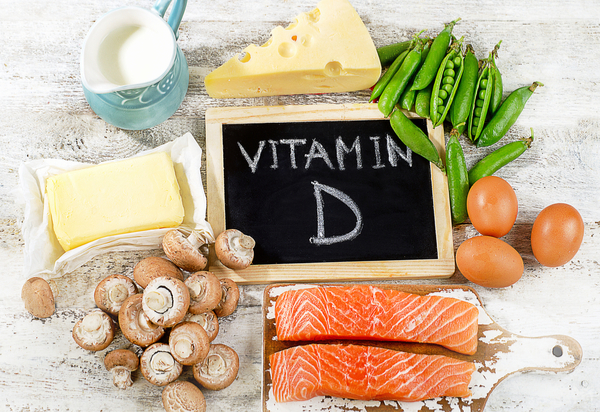Boost Your Vitamin D for Better Health
Vitamin D is an essential part of maintaining your overall health and wellness, yet most people don’t realize how important it really is. Almost all of us have probably had suboptimal levels of this fat-soluble nutrient at one point or another, as just over half the global population achieves adequate vitamin D status. All told, researchers believe that around 88% of people around the world have less-than-optimal levels of vitamin D, a situation which can mean increased risk of certain health challenges.1
With these numbers in mind, here are the three time-tested ways to increase your body's vitamin D levels:
1. Sunlight
The most common and natural way to soak up vitamin D is via the largest organ in your body: your skin! How much vitamin D you’re actually being exposed to (and soaking in) from the sun can vary greatly, though, depending on the time of day, your skin's pigmentation, your geographical location and whether or not you've applied sunscreen.
Most of us love a good beach day, but keep in mind that it’s not always necessary to lay out in the sun for long period of time in order to obtain the vitamin D we need. It happens relatively quickly; usually around half the time it takes for your skin to begin to burn, which could be just 15 minutes for a very fair skinned person, or a couple hours for those with an olive or dark complexion.
Dr. Stephen Honig, director of the Osteoporosis Center for Joint Diseases, explains, "if you're going to get it from the sun, about 20 to 25 minutes of exposure is helpful.”2 When it comes to choosing a sunscreen that's right for you, sunscreens with a sun protection factor (SPF) of 8 or more appear to block UV rays. However, most people don’t apply sufficient amounts of sunscreen, cover all sun-exposed skin or reapply sunscreen regularly in an effort to avoid sun damage. Therefore, skin likely synthesizes some vitamin D even when it is protected by sunscreen as typically applied.3
2. Food
Food is another way to ensure you’re getting the right amount of nutrients, including vitamin D. The Recommended Dietary Allowance of vitamin D is set at 600 IU (international units) per day for everyone aged one year to 70.3 However, some recommendations are higher, such as the call from the Swiss Federal Food Safety & Veterinary Office for adults over 65 to aim for closer to 800 IU daily.4
Still others recommend even higher daily intake of vitamin D, such as Althea Zanecosky, a registered dietitian, nutrition educator and former spokesperson for the Academy of Nutrition and Dietetics. She says, “many physicians are now advising 2,000 mg daily for those with low blood levels."5
Here is a list of foods known to provide additional amounts of vitamin D to your diet.2
- Rainbow trout (645 IU per serving)
- Cooked Salmon (570 IU per serving)
- Canned light tuna (50 IU per 4 oz)
- Fortified cow's milk (100 IU per 8 oz)
- Yogurt (80 IU per 6 oz)
- Fortified orange juice (100 IU per 8 oz)
- Beef liver (50 IU per 3.5 oz)
- Eggs (40 IU per egg)
- Cod liver oil (1,300 IU per tablespoon)
3. Supplements
Vitamin D is a fat-soluble nutrient, meaning it has potential to be stored in the body and isn't as easily excreted as water-soluble vitamins. It's always a good idea to talk to a doctor before adding any new supplements to your health routine, but remember that supplements can help plug any nutritional gaps which may exist in your diet.
The precursor to vitamin D can be found in both plant and animal products, but there are two primary types of supplementary vitamin D:6
- Vitamin D2: made by irradiating plant life (e.g., found in mushrooms and most fortified dairy products)
- Vitamin D3: typically made by your body upon exposure to sunlight
Research suggests that vitamin D3 is twice as effective as vitamin D2 in raising levels of the nutrient in the body. The Department of Nutritional Sciences at the University of Surrey suggests that people who aim to consume more D3 through eating fish, eggs or taking supplements will be twice as likely to raise their vitamin D levels compared to those only consuming vitamin D2 from the following sources: mushrooms, fortified bread, or D2 containing supplements.7
For more on Vitamin D, read Say Hello to the Sunshine Vitamin: Top Foods High in Vitamin D and see the amazing alphabet vitamins your should know for everyday wellness in Amazing Alphabet Vitamins: The Six Vitamins You Need to Know.

About Lindsey Toth, MS, RD
Lindsey is a nationally recognized registered dietitian and nutritionist with a soft spot for ice cream. She empowers people to take charge of their health by finding the balance between the pleasure and nourishment in food. Her philosophy is that you should take care of your body because it’s the only permanent home you have. It’s what inspired her to pursue a career in nutrition.
*These statements have not been evaluated by the Food and Drug Administration. These products are not intended to diagnose, treat, cure, or prevent any disease.
Sources
1. Bridging the Vitamin D Gap. IADSA. Read source
2. What Are Good Sources of Vitamin D? Health. Read source
3. Update in Vitamin D. National Library of Medicine. Read source
4. Daily Vitamin D Supplement. Asia Food Journal. Read source
5. 15 Healthy Foods that are High in Vitamin D. Prevention. Read source
6. Vitamin D3 vs. D2 What's the Difference? Global Healing. Read source
7. Vitamin D Research. University of Surrey. Read source




